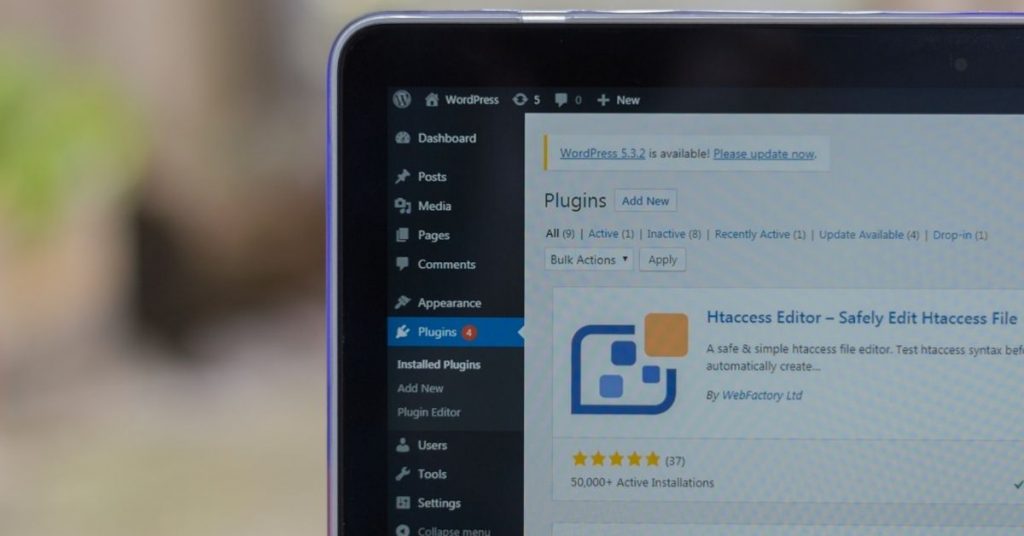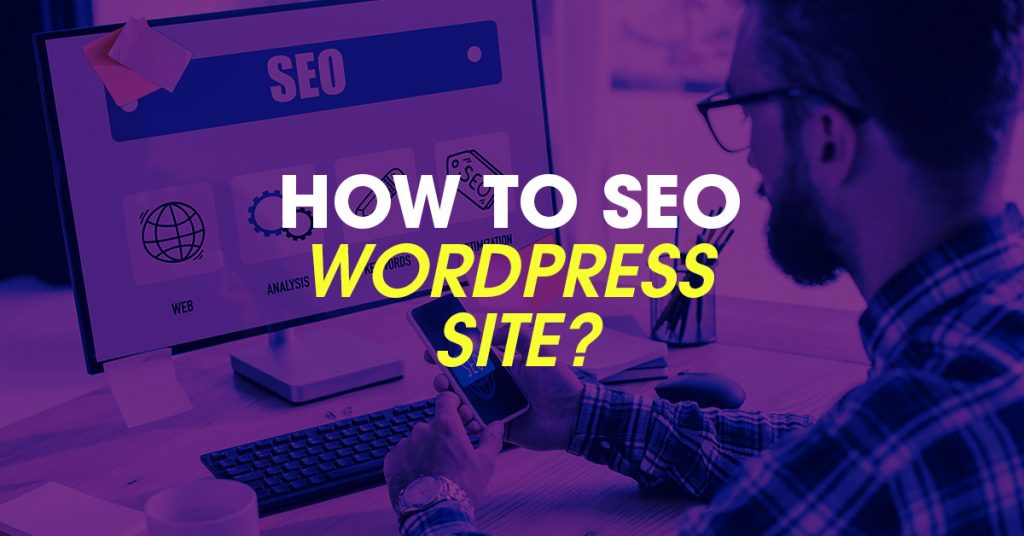I’ve noticed questions in many forums asking about how to SEO WordPress websites. Setting up a search engine optimized WordPress site requires a basic understanding in various domains, from keyword research, web design and digital marketing. Google takes into account a large number of factors to rank a page in a certain position. These factors as you might already know can be easily categorized as:
- On-Page Factors: These are the factors that depend on the content of our page. You have full control over On-Page factors.
- Off-Page Factors: These are the factors that do not depend on our website and content but on external website and content. However, you do have some influence on off-page factors.
Out of all the On Page SEO factors, there are few key areas that can be prioritized:
- Website loading speed
- Heading structure
- Meta titles and meta descriptions
- Structured data
In this article, I’ll be taking you deeper into these sections so that you can perfectly understand how to optimize your WordPress site to have a perfect On-Page SEO score.
Web Performance Optimization (WPO)
WPO stands for Web Performance Optimization. In simple terms, it is the implementation of measures that optimise your WordPress site, improve the loading time and the user experience. To implement this successfully, it is mandatory to work on the loading speed and the structuring of headings, together with the descriptions and the use of structured data.
How WordPress Works
How does WordPress websites work? WordPress is a platform that actually consists of a CMS that has been developed in PHP under the MySQL database for data storage. Despite being created and launched in 2003, WordPress consists of a well-planned technical structure and it has become the favourite of millions of web designers. Since anyone with limited programming knowledge can create a WordPress page thanks to its simple operation, we believe it is important to consider how to set up an SEO-optimised page using this CMS as a base.
Loading Speed
The SEO of a website created in WordPress depends, first, on the loading speed. The CMS offered by WordPress is fast, but it also has many plugins and themes and templates to choose from. So, if we overuse (like a plugin for each and every function), the loading speed will suffer. With certain notions of web development, we know how to choose the essential elements to avoid unnecessary plugins, redirects and reduce slowdowns. Remember to keep only the essential plugins. The success of your website depends on its usability. If the user experience is highly satisfying, you will be more successful with your organic SEO rankings. The loading speed is key in this regard.
Factors influencing Loading Speed
I’ve listed down the factors that will influence the speed of loading your WordPress website:
- Connectivity: these depend on networks and internet connection.
- Server: involves hosting and it’s quality and capacity.
- Website: depends on the architecture of the website and its configuration.
We can see that most factors depend on ourselves and are under our control. The only one that is beyond our control is the internet connection. We cannot know what type of internet connection the visitor has. But we can definitely optimise and configure your website so that, even in the worst conditions, it loads at a good speed. For this, a good hosting or server and an excellent website design will be key elements.
Fast, efficient and reliable Hosting
The first thing you need is to choose a good web hosting provider. This should not be chosen lightly because of price or brand preferences, but because of efficiency, since the most important requirement is that your website should be able to offer its maximum performance.
You will have to take into account the technical characteristics offered by the hosting providers before purchasing the service, such as the hardware and the assigned resources:
The storage space must have at least 1GB available, with the ability to scale. Also, check on the monthly transfer rate, usually, it’s at 50 GB – which is more than sufficient for text and images. Technical support and customer care are essential while free migration is a basic aspect to consider and helps build confidence. Additionally, security and user-friendly platform interface (hosting settings and cPanel) are essential. Hosting performance is the best way to measure server quality and you can check it with the following tools:
- Benchmark Script: for analysing times
- Load Impact: to check the stability
- WebPage Test: to measure the response of the server as ByteCheck
Use of Plugins

A plugin is an application that adds additional functions or relevant features to your website. They are necessary for the creation of any page, but it is important to emphasize that only the necessary plugins should be used. Installing unnecessary plugins and too many plugins lead to security breaches, slow loading speeds and sometimes crashing the entire website. Also, make sure the plugins are constantly updated.
When setting up and doing SEO for a WordPress website we have to have the best plugins to accelerate the loading speed.
Which Plugins to choose?
- Yoast SEO is a tool developed to optimize web content and it directly tracks and helps you to write compelling content. It identifies the location of keywords and measures their frequency. It also allows you to preview descriptions and snippets, which are the fragments of the entry that appear in the search engines.
- W3 Total Cache contains specific functions for configuring the cache guard in multiple destinations. You can also use a tool called Minify, useful to minimize and optimize Javascript, HTML and CSS codes.
- WP Rocket is a very easy to configure and quite effective cache plugin, especially when you need a single page cache. It does not consume many resources to implement the pre-cache system. It contains Minify / Combine, which is a powerful Javascript, HTML and CSS optimization system. Other helpful features are that it integrates very well with WooCommerce, efficiently works with any CDN service.
- Kk Star Ratings is a Rich Snippets plugin and brings relevance to the results. It is the application that allows the user to rate the content of the page by placing stars that will be visible from the snippet.
- Really Simple SSL detects the settings needed to configure the website, which can be viewed in HTTPS.
- Cookie Notice for GDPR & CCPA facilitates compliance with the regulations of the General Data Protection Regulation and California Consumer Privacy Act, which is obligatory for sites visited in the European Union and the State of California. It includes the user’s consent to the use of cookies.
- Contact Form 7 is the right one to create contact forms quickly and efficiently. It is free and it is adapted to the needs and characteristics of the theme. It collects the data and includes them in an email to send without saving them.
- Antispam Bee serves to avoid concerns about annoying spams that affect traffic (spam score). A WordPress account with a KEY API is required. It is an automatic filter that locates and removes any Spam messages.
Define the SEO Strategy
To define the SEO strategy, it is necessary to focus on the potential customer / audience and what actions are expected.
Example: Complete a survey, fill out a form, subscribe to a newsletter, download a file or to complete a purchase.
Based on this, an SEO strategy must be planned from the beginning, and the first step would be a thorough keyword research. You should choose keywords that describe the specific objective and not result in variations that don’t match with the content.
The keywords must be strong, logical and consistent. You should periodically test and filter the chosen keywords based on its performance. You can use the keyword planner tool for this task. Going forward, you will have enough data gathered on your Google search console to identify the top keywords that help your website rank.
Next, the keywords must be included in the title, the URL and even the alt attributes of the images. The WordPress SEO plugin is very useful for determining the balance between quality content and the number of keywords used. As I mentioned before, you can use Yoast SEO or RankMath plugin for this task.
Analyze the competition
A thorough analysis of competition (competitor strengths and weaknesses) will include identifying their top keywords. This helps you understand and identify the top keywords that attract most visits to their website and which section/pages on their website.
However, this task is a lengthy process if you try to do it manually on Google sheets. So the best method is to use a very versatile tool called Ahrefs‘ Keywords Explorer. The Keyword Generator tool Ahrefs contains an extraordinary database of 3.1 billion keywords in over hundred countries.
It uses four algorithms to generate them, which can be used separately or in combination:
- Sentence linguistics (semantics)
- Similar terms
- Rank position (extending traffic to the top 10 of the pages related to the topic)
- Suggestions
Ahrefs goes further and provides the necessary metrics to know the search volume and score the Keyword Difficulty. However, unlike the keyword difficulty shared on Google’s keyword planner, Ahref’s’ figure is not very reliable but allows you to get a general idea.
Conducting good keyword research
Keyword research is an essential part of SEO optimization on a WordPress website. Since it’s about content that needs constant updating, each entry must have essential keywords to be ranked and positioned at the top. Apart from Google Keyword Planner (free) and Ahrefs, the other recommended tools for doing good keyword research are:
- Keywordtool: It uses Google’s autocomplete technique and its free version generates more than 750 longtail suggestions for each term. Find the keywords hidden by advertisers that are most in-demand and most profitable.
- AnswerThePublic: It’s useful to discover potential topics related to the keyword you enter in your search engine. It has a free version and is very easy to use. It will provide the following results:
-
- Questions asked by users on the subject
- Lists of prepositions (how, for, with, versus, etc.)
- Alphabetical order
Choosing a well-optimised theme
For a good choice of theme to facilitate SEO, it must meet the following characteristics:
- Page loading speed
- A design that’s easily adaptable or responsive: so that it can be easily seen from any device
- Better experience or usability: The user must feel comfortable navigating your website. It must be well organized. To do this, it is important to check if there are problems with the menu, typography and coherent hierarchy between elements.
- Compatibility with different social networks.
- A well-structured code in HTML5, CSS, JavaScript and PHP. So that there are no loopholes that a hacker can manipulate.
Header structure
When setting up an SEO WordPress site, the header structure had to be taken into account. In order to organize a website properly and improve the user’s ability to navigate, it is necessary to structure it into tags, mainly the H1, H2 and H3, although more can be added if necessary, even up to H6 or beyond. These labels have weight in SEO positioning and organic optimization. That is why we are going to define them briefly.
H1 Tag
This is the title of each page and has the most weight in the optimization within the tags, so it is important that you enter the relevant keyword in your title.
H2 Tag
In this case, we refer to subtitles, also called H2 titles. They are used to complete and structure the content of a page. They should be followed by a minimum of 300 words before the next subtitle and should relate and include a specific topic. It is also important that they add the keyword and some synonym in relation to the subject.
Other subtitles: H3 and others
Titles and subtitles after H3 become less important (level of importance in the sub-topic) and therefore less impactful on SEO for a WordPress website. However, a clear and well-organised presentation of the information is a basic ranking criterion for search engines, as it is a detail that is interpreted as user-friendly content.
Meta titles and meta descriptions

Next, we move on to other key elements when setting up an SEO WordPress website. These are the meta titles and the meta descriptions. I’ve shared their importance in detail below.
Why are Meta Titles and Meta Descriptions important
Nowadays, it is not enough to create interesting and quality content. Due to millions of websites on the internet making great content, the competition is very high. The user does not have enough time to review all the available content, so he or she usually focuses on the first few results of the SERPs (search engine results page), especially the first three.
To reach this TOP 3 positions in searches with your WordPress website, you have to continuously do your best to in SEO. A mandatory requirement for achieving this is through a meta description and meta title. It’s analysed by the search engines and estimated as more or less significant against the search term according to the content quality, use of keywords, etc.
How to enter meta titles and meta descriptions in a WordPress page
Although Google states that the use of the exact keyword in a meta description or meta title is no longer important for WordPress SEO, it is still worthwhile to use it. To make these changes more rapidly throughout your WordPress site, we can use popular SEO plugins. WordPress has many plugins for creating meta titles and meta descriptions. The most famous is Yoast SEO but it is not the only one. I would also recommend RankMath as an alternative. Whichever plugin that you would be using, adding the meta title and meta description is necessary for SEO.
To complete this task successfully, you can follow these 3 simple steps:
- Go to advanced WordPress settings and enable the plugin that you will use to implement the meta titles and meta descriptions.
- Once you have completed a page with its content, images and links, fill in the fields from the plugin by adding the meta titles, keywords, meta description, etc. Fill in the snippet and the requested fields.
- Publish the content and share it so that it reaches as many people as possible. Attracts as much traffic as possible so that it starts to get the attention from search engines and gets indexed faster.
In summary, you can understand that with a simple plugin your WordPress website can be effectively optimized.
Choosing the right structure for the site
It is essential to avoid a website where categories outnumber the tags. This happens often when you create a new category and start assigning posts under the new category without assigning tags. It’s chaotic and hinders the natural indexing process for the search engines. The correct order is that the categories are more important than the tags and the main categories over the subcategories. The following steps might help:
- Use friendly URLs. You can easily do this in the administration panel from “Settings > PermanaLinks”. Next, you can change the default structure. It will include the title of the entry with its respective keyword.
- Avoid creating sub-domains as well as similar multiple categories. It’s recommended that they are kept limited and well thought out.
The silo structure in the searches works like this:
- The categories will inevitably have their URLs from the root.
- Each post will have a category as a top folder.
- The subcategories will be separated by a ‘/’ and each post included will depend on it.
This is where importance is given to what the user reads/consumes, since none of the tools and advise explained thus far will be successful if the user is not interested in the content on your WordPress website. Valuable content will create you a loyal audience and perhaps they might recommend you on social media and therefore attract more traffic. To create valuable content you need to:
- Write useful information.
- Authenticity and quality must prevail. Copied content attracts penalties in search engines and generates distrust in the reputation of your page.
- The accuracy, especially in the cited sources since false information will not attract readers.
- Avoid spelling and syntax errors as much as possible.
- Double-check the links to ensure that none of them are broken links.
If the information is going to be extensive, for an example: a post of up to 2000 words. Then it’s advisable to structure it in an orderly and coherent method and even include some optimized images. Following the order below would increase your ranking:
- Introduction
- Description
- Advantages
- Disadvantages
- Conclusion
- Case studies
Social networks have analytical tools that could shed light on the acceptance of content. Facebook Insights and Twitter Analytics provide information on page sessions, bounce rate, number of times your posts have been shared, comments, etc. Studying this data will allow you to better optimise the published content.
Use of structured data
The final point that we will focus in setting up your SEO WordPress Site will be the use of structured data. I’ve explained what they are and why they are so important.
What’s Structured data
Also called microdata or Schema, structured data are important for your SEO strategy. Search engines make use of this information to provide users with more useful and immediate answers according to the nature of their needs. So, when you do a search, for example, on ‘online marketing’, the search engine will use its readings of Rich Snippets or structured data extracted from various websites and will show you those it considers to be of higher quality and more interesting for your specific need.
Structured data helps the SEO of any business, be it a restaurant, an eCommerce platform or even a blog. Schema data in this section is very useful and would display information such as opening hours, listings, addresses, menus, etc.
Plugins for working with structured data
Working the structured data on SEO WordPress Site requires the use of some very interesting plugins. Some of the most productive plugins include:
- Schema & Structured Data for WP & AMP: It adds JSON + LD fragments to the website, hence it’s innovative compared to other plugins. This is the best way to communicate with search engines as it gives very explicit clues about the meaning of the content.
- Markup (JSON-LD): It offers complete configuration panel to select between different types of data for articles, publications, events, business, navigation, etc.
- WP SEO Structured Data Schema: Allows to completely manage the site while offering a number of options from a settings panel on each WordPress page.
Benefits of using structured data
You might have already noticed the importance of using structured data on your WordPress website. Any user interested in your services can access that information without any complications while on the SERP (Search Engine Results Page). This improves the relevance and usability of your website, which in turn optimises and improves its organic positioning in the SERPs of any search engine, whether it be Google, Yahoo or Bing.
Link Building Strategy
Link Building is one of the most popular Off-Page SEO strategies. The literal translation of the term would be building links, where you obtain links to your website from some authoritative and subject-related entry or post. It can be from external domains or internal (within your website). Internal linking has a lesser impact compared to SEO backlinks from external sources, but if it is done logically it will be rewarded.
There are two types of link tags: Dofollow and Nofollow. Dofollow links are useful for search engines to discover new content and pages on the web. This is how confidence is transferred since they transmit authority (link juice) to the destination website.
- Obtaining it brings an improvement to the positioning
- Their excess can be penalised
Nofollow links are created using an HTML attribute used to prevent search engines from following those links. Unlike the Dofollow links, Nofollow links tell the search engines not to follow it. However, there must be a good balance between Dofollow and Nofollow (A ratio like 30 to 70).
Even if the search engines do not follow a Nofollow link, a well placed and relevant link can make people click and navigate through it and therefore:
- Improves the exposure of the website
- Creates new followers and users; which becomes quality traffic
- Balances the presence of Dofollow links
Tips and tricks
After evaluating all these factors on how to SEO WordPress website, I’ve also shared with you some tips and tricks that will be useful.
Assign a dedicated separate folder for file uploads
When you assign a dedicated separate folder outside the main WordPress folder, for example, by sending it to a subdomain, you’ll notice that backups are more manageable and parallel browser download speeds get improved.
Deleting additional/obsolete meta tags in the header section of your WordPress HTML source code will help secure your website from hackers – who are looking for older, less secure versions to attack your site.
Don’t let anyone outside the project browse your folders
No one should be able to browse your WordPress files unless you allow it. To do this, you have to add the .htaccess file to the WordPress installation root directory.
Disable HTML in comments
You can avoid HTML in the comments section of your WordPress website. Even if those links are nofollow links, you can make them not appear as hyperlinks. You can do this by adding the below code in your functions.php file. You can access this section from the administration panel “Appearance > Theme Editor > Theme Files” and click on the functions.php file.
remove_filter( 'comment_text', 'make_clickable', 9 );
Disable post revisions
WordPress’ review function is very useful for tracking possible changes in posts. For example, posts edit history. It also allows you to go back to an earlier version. However, if you increase the size of the WP_Posts table, it is one additional row that is added to the database. This increases the database size. To deactivate it, go to the WordPress root directory and open the wp-config.php file. Next, add the below code:
define('AUTOSAVE_INTERVAL', 300 ); // seconds
define('WP_POST_REVISIONS', false );This code will disable your future revisions from being saved and also it would increase the autosave time interval from 1 minute to 5 minutes.
Complete SEO WordPress Site

Take advantage of these tricks, tips and information to complete SEO your WordPress website and starting getting ranked organically. It takes time but you can speed it up by generating a decent amount of traffic through multiple channels.
You can have a look at setting up a Google Ads campaign using a Single Keyword Ad Group structure here. Once you get ranked in Google searches it would allow you to reach a wide audience and to be competitive and eventually stand out from the competition.
I hope the details in this article would have answered your questions on how to SEO WordPress sites. However, if you would like to start immediately optimizing your site, you can read my resource on SEO in 3 basic steps.
Got any questions? Leave a comment below.
